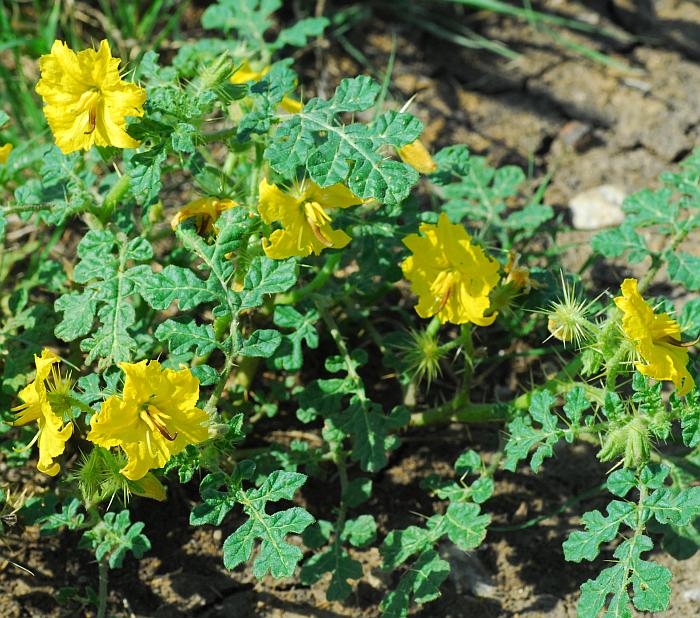Solanum rostratum Dunal
Buffalo Bur

Introduced
CC = *
CW = 5
MOC = 45
© SRTurner
Solanum rostratum DunalBuffalo Bur | |
 |
Introduced CC = * CW = 5 MOC = 45 |
© SRTurner |
|
Family - Solanaceae Habit - Taprooted annual forb. Stems - Loosely ascending to erect, to 70 cm, multiple from base, with spreading branches, densely pubescent with stellate, nonglandular hairs, these sessile or stalked; armed with numerous, straight, pale yellow prickles 3-8 mm long, the stem sometimes purplish-tinged at the prickle attachment points.
Leaves - Alternate, pinnately lobed, petiolate, armed with straight, pale yellow prickles, these along the petioles and main veins of both surfaces. Petiole to 9 cm long. Blades 3-15 cm long, simple but deeply 1-or 2-times pinnately lobed or parted, elliptic or oblong to broadly ovate, the lobes narrowly to broadly oblong or obovate, rounded at the tips, broadly attached at their bases, the margins otherwise entire, the surfaces moderately to densely pubescent with sessile, stellate, nonglandular hairs, these mostly with the central branch erect and elongate.
Inflorescences - Axillary racemes of 3-9 flowers, the axis with scattered prickles, elongating as the fruits develop, the flower stalks not jointed, uniformly slender to moderately stout. Flowers spreading, the stalks becoming more or less ascending as the fruits develop.
Flowers - Calyces 7-12 mm long at flowering, the tube 1.5-2.5 mm long at flowering, becoming enlarged to 7-12 mm at fruiting, enclosing the fruit, deeply 5-lobed at flowering, the lobes more or less equal, linear to very narrowly oblong-triangular, the outer surface densely prickly and stellate-hairy (the hairs sometimes breaking off after flowering, leaving the short, erect stalk). Corollas 8-14 mm long, slightly zygomorphic, bright yellow, shallowly lobed, the lobes broadly triangular, often appearing somewhat ruffled or irregular along the margins, tapered abruptly, the lower 2 lobes more strongly extended into slender, tips, spreading at flowering, the inner surface glabrous, the outer surface stellate-hairy. Anthers unequal, 4 of them 7-9 mm long, more or less oblong, slightly tapered toward the tip, yellow, the anther of the lowermost stamen 11-14 mm long, long-tapered and curved upward toward its tip, usually reddish-or purplish-tinged, all dehiscing by terminal pores. Ovary superior, 2-locular, fused to the inner surface of the calyx tube, the style yellow, glabrous, 1.7 cm long, angled downward and to the side from the anther ring, somewhat upward-curved. Fruit a globose berry surrounded by the accrescent calyx, to +1cm in diameter, many seeded.
Fruits - Globose berries 0.7-1.1 cm long, lacking stony granules, hidden within the burlike, densely prickly calyx, green (eventually tan to light brown), with pale yellow, straight prickles. Seeds 2.3-2.7 mm in longest dimension, broadly ovate to nearly circular in outline, moderately flattened, unwinged, the surface minutely pitted or with a fine network of ridges, usually also coarsely wrinkled, dark brown to nearly black, the ridges sometimes grayish brown.
Flowering - May - October. Habitat - Streambanks, upland prairies, pastures, farmyards, roadsides, open disturbed areas. Origin - Native to the southwestern U.S., considered introduced in Missouri. Other info. - Nasty, nasty, nasty. This plant is not one to be handled casually, let alone stepped on. The spines are very dense, stiff, and sharp. The plant is just brutal. Identification in the field is easy, just touch it and you'll know what plant you have. Like many species of Solanum, it is also somewhat toxic. The plant has been collected from numerous counties in Missouri but is not generally common, at least on the eastern side of the state. It becomes much more common in states to our west, and is considered noxious in the Northwest. The spines can cause injury to livestock (and careless humans), and if entangled in sheeps' fleece will decrease the value of the wool. The plant is actually very attractive visually and could even be considered as an interesting garden specimen if pets are not present, but for obvious reasons it is best not handled. Photographs taken off Prairie View Rd., Platte County, MO., 6-2-00, and off Hwy 13, St. Clair County, MO., 8-15-03 (DETenaglia); also at Tallgrass Prairie National Preserve, Chase County, KS, 9-1-2012, and on a street corner in Bonne Terre, St. Francois County, MO, 9-2-2016 (SRTurner). |